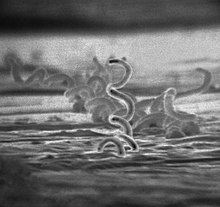
A | B | C | D | E | F | G | H | CH | I | J | K | L | M | N | O | P | Q | R | S | T | U | V | W | X | Y | Z | 0 | 1 | 2 | 3 | 4 | 5 | 6 | 7 | 8 | 9
| Spirochaetes | |
|---|---|

| |
| Treponema pallidum, a spirochaete which causes syphilis | |
| Scientific classification | |
| Domain: | Bacteria |
| Phylum: | Spirochaetota Garrity and Holt 2021[3] |
| Class: | Spirochaetia Paster 2020[1]: 471–563 [2] |
| Orders | |
| |
| Synonyms | |
| |


Fig. 2: A side-view of a spirochete cell which shows two axial filaments in opposing motion. One axial filament rotates in a clockwise orientation; an adjacent axial filament rotates in a counter-clockwise orientation. Rotation of the endoflagella creates torsion and drives the corkscrew rotation of the cell.
Fig. 3: An expanded view of the cellular membranes that surround endoflagellum. Both the inner and outer membrane contain a phospholipid bi-layer, with non-polar fatty acid chains in-ward of polar phosphorus heads. Peptidoglycan, the cell wall, provides structure in bacterial microorganisms. Axial filaments are superior to the peptidoglycan.
A spirochaete (/ˈspaɪroʊˌkiːt/)[4] or spirochete is a member of the phylum Spirochaetota (also called Spirochaetes[5] /ˌspaɪroʊˈkiːtiːz/), which contains distinctive diderm (double-membrane) Gram-negative bacteria, most of which have long, helically coiled (corkscrew-shaped or spiraled, hence the name) cells.[6] Spirochaetes are chemoheterotrophic in nature, with lengths between 3 and 500 μm and diameters around 0.09 to at least 3 μm.[7]
Spirochaetes are distinguished from other bacterial phyla by the location of their flagella, called endoflagella, or periplasmic flagella, which are sometimes called axial filaments.[8][9] Endoflagella are anchored at each end (pole) of the bacterium within the periplasmic space (between the inner and outer membranes) where they project backwards to extend the length of the cell.[10] These cause a twisting motion which allows the spirochaete to move about. When reproducing, a spirochaete will undergo asexual transverse binary fission. Most spirochaetes are free-living and anaerobic, but there are numerous exceptions. Spirochaete bacteria are diverse in their pathogenic capacity and the ecological niches that they inhabit, as well as molecular characteristics including guanine-cytosine content and genome size.[11][12]
Pathogenicity
Many organisms within the Spirochaetota phylum cause prevalent diseases. Pathogenic members of this phylum include the following:
- Leptospira species, which causes leptospirosis[13]
- Borrelia burgdorferi, B. mayonii, B. bissettiae, B. garinii, B. afzelii, B. spielmanii, B. lusitaniae, which cause Lyme disease.[14]
- Borrelia recurrentis, which causes relapsing fever[15]
- Treponema pallidum subspecies which cause treponematoses such as syphilis and yaws.
- Brachyspira pilosicoli and Brachyspira aalborgi, which cause intestinal spirochaetosis[16]
Salvarsan, the first partially organic synthetic antimicrobial drug in medical history, was effective against spirochaetes and primarily used to cure syphilis. Additionally, oral spirochaetes are known to play a significant role in the pathogenesis of human periodontal disease.[17]
Taxonomy and molecular signatures
The class currently consists of 14 validly named genera across 4 orders and 5 families.[18][19][20] The orders Brachyspirales, Brevinematales and Leptospirales each contain a single family, Brachyspiraceae, Brevinemataceae and Leptospiraceae, respectively. The Spirochaetales order harbours two families, Spirochaetaceae and Borreliaceae. Molecular markers in the form of conserved signature indels (CSIs) and CSPs have been found specific for each of the orders, with the exception of Brevinimetales, that provide a reliable means to demarcate these clades from one another within the diverse phylum.[19] Additional CSIs have been found exclusively shared by each family within the Spirochaetales. These molecular markers are in agreement with the observed phylogenetic tree branching of two monophyletic clades within the Spirochaetales order.[19] CSIs have also been found that further differentiate taxonomic groups within the Borreliaceae family that further delineate evolutionary relationships that are in accordance with physical characteristics such as pathogenicity (viz. Borrelia emend. Borreliella gen. nov.).[21] However, this study has been criticized, and other studies using different approaches do not support the proposed split.[22] The new naming system for the Lyme and relapsing fever Borrelia has not been adopted by the scientific literature.[22]
A CSI has also been found exclusively shared by all Spirochaetota species.[19] This CSI is a 3 amino acid insert in the flagellar basal body rod protein FlgC which is an important part of the unique endoflagellar structure shared by Spirochaetota species.[23] Given that the CSI is exclusively shared by members within this phylum, it has been postulated that it may be related to the characteristic flagellar properties observed among Spirochaetota species.[19][23]
Historically, all families belonging to the Spirochaetota phylum were assigned to a single order, the Spirochaetales.[11][12] However, the current taxonomic view is more connotative of accurate evolutionary relationships. The distribution of a CSI is indicative of shared ancestry within the clade for which it is specific. It thus functions as a synapomorphic characteristic, so that the distributions of different CSIs provide the means to identify different orders and families within the phylum and so justify the phylogenetic divisions.[19]
